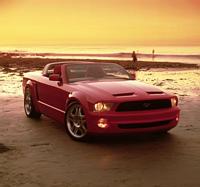Detroit Auto Show: Ford Mustang GT Concepts: Modern
'Performance' Art
DETROIT, Jan. 5, 2003; The view from behind the wheel
of a Mustang GT concept is as good as the view from afar. The Mustang GT
concept vehicles put the driver and the passenger in a most enviable
place -- the future of the pony car.
While the evocative unmistakable exterior designs draw admirers, it is the
inviting interiors that demand closer inspection. The modern interior designs
pay homage to another era in Mustang history while their use of high-quality
materials, precision craftsmanship and technical innovations point to Mustangs
to come.
The Mustang GT coupe and convertible concept cars' interiors are awash in
supple red and charcoal leather and accented with billet-aluminum hardware
that gives an appearance that is robust and highly technical.
"These incredible interiors speak volumes about where Mustang and Ford are
headed in the future," said J Mays, Ford Motor Company, vice president,
Design. "The functional, contemporary look of this interior and its precise
execution set a new standard for muscle car design."
Two-Place concepts
Upon opening the door, both driver and passenger will see the Ford logo
proudly displayed on a billet-aluminum sill panels.
Unlike production Mustangs, the Mustang GT concepts have only two
seats -- racing-inspired with red perforated leather. The interiors of the GT
coupe and convertible are executed with the same performance characteristics,
with the coupe configuration boasting a key element more typical of racing.
Instead of a 2+2 design, the Mustang GT coupe's strut support linking the two
rear shock towers serves as the primary hold down for a backseat mounted spare
tire. Consistent with the trim throughout the interior, a billet-aluminum
strut brace holds the tire in place. Early Shelby racers used this functional
design.
Four-point harnesses brace the occupants for what they see next. The
cluster instrumentation is unique, but features a familiar, round optical
look. The mechanicals of the display resemble the movement of a fine
timepiece. As the driver stirs gearbox, the tachometer and speedometer put on
a show like no other car. The bezels of the gauges are trimmed with sprocket
gears around the inner circumference. Rather than using needle pointers, the
gauges feature a small, gear-driven, trolley scored with indicator lines that
rides around the inside of the bezel matching the rpms and groundspeed.
The upper brow of the dash is covered in charcoal leather, reminiscent of
past era Mustangs.
From that point down, a billet-aluminum band makes the transition to the
future. Two air vents and an analog clock form the center cluster. Below the
trio, a row of cockpit switches allow the driver to control suspension as well
as set the air/fuel mixture.
The center stack displays a boost gauge for the supercharged engine. The
gauge gives the driver a visual indication of actual boost from a lean to rich
mixture. The circular gauge uses an analog indicator similar to those found
in the vehicle's tachometer and speedometer.
The billet-aluminum shifter controls six manual gears in the coupe and
five automatic gears in the convertible, each transmission contributing to the
concepts' athletic, muscle-car acceleration capability. A similarly designed
parking-brake lever is positioned nearby on the console.
Like the 1967 model, the steering wheel has three spokes with a center hub
marked by the Mustang GT logo in a precision typeface, a cue that carries over
to the front quarterpanel and fender badging. From a distance, it harkens to
the original GT bold font. Up close, "Mustang" is inlaid underneath: two
components wedded into a single, simple statement.
The cluster gauges, three-spoke steering wheel and innovative cockpit dash
design are clear cues from a rich Mustang history, but there is no denying
that Ford' s new Mustang GT concepts' celebrate that heritage in a
dramatically modern interpretation of the future.



